August 2006: Conversations in Cuba
This is a report of my visit to Cuba with a delegation of British MPs as part of the All Party Parliamentary Group on Cuba. Click on the headings to go to each section
Back After Four Years, Biotechnology for the People, A Flavour of Cuban Education, Villa Clara Province, Rural Cuba, Community Services and Local Politics, The Bay of Pigs, Politics and Rights, The Prison System, The Merits of Rehabilitation, Drug Policy, The Miami 5, Pragmatism in the Cigar Factory, Human Rights and Prisoners of Conscience, International Relations and Openness, Men in Havana, Final Thoughts
Long after I have forgotten the anxiety I had at Havana airport when I thought my luggage had been lost, my first memory of this trip will always be the sight of our 29 year old interpreter, Julio, swelling up with pride as he told us that last time he sat on the sofa in the living room of our guest house he had been next to the “Commander-in-Chief”, Fidel Castro himself. Like so many other people we met, he is proud of the Revolution and of the achievements of his Country. A consistent theme throughout the visit was the attribution of blame for Cuba’s economic problems on the US blockade. US inspired attempts at destabilising the Country were blamed for the difficulties in Cuba being a more open society.
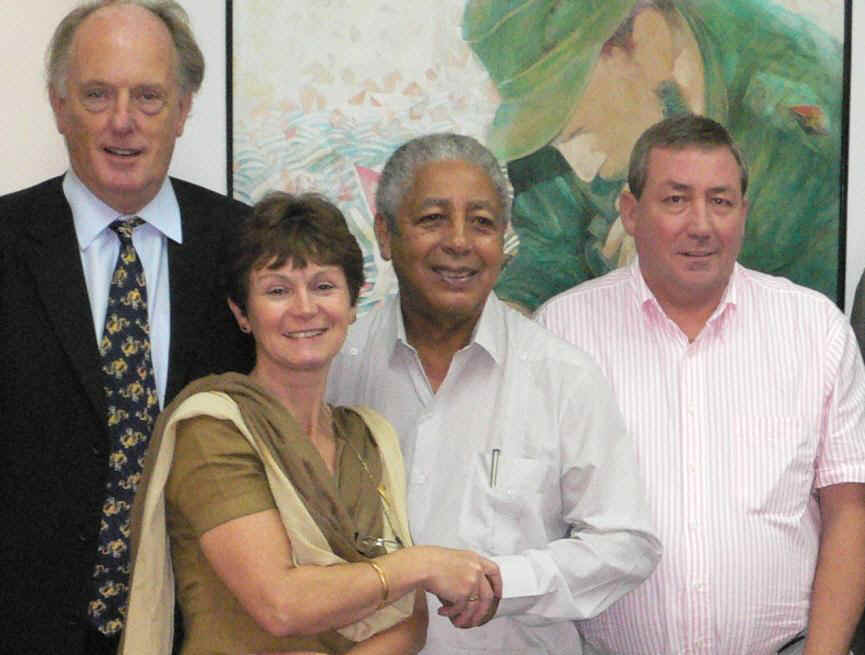 |
Such sentiments were expressed by the two politicians we met on our first full day in Cuba, a Friday. Both were deputies (MPs) in the National Assembly of the People’s Power: Mandela-look alike Ramon Pez Ferro, the equivalent of the Foreign Affairs Select Committee Chair, and poet/politician Dr Roberto Fernandez Retamar, the Chair of the Cuba-GB Parliamentary Friendship Group had both been young men at the time of the Revolution. They explained that the blockade not only affected trade with the USA but also with other countries because companies were unwilling to put contracts with the US at risk by trading with Cuba. An example given was of the Americans pressurising the Swiss bank, UBS, not to accept payment of 30,000 Swiss francs for Cuba’s subscription to the Geneva-based Inter-Parliamentary Union. The malign intent of President Bush to intervene in Cuba’s affairs went as far as even to appoint a Governor-in waiting (for Castro’s demise) Caleb McCarry, who is receiving a salary from the US. Though Bush and Co clearly think the Cuban system will fall apart when Castro dies, this visit convinced me this is just as much wishful thinking, as occurred at the time of the abortive attack (in 1961) on the Bay of Pigs. Later we visited the museum commemorating the Cuban victory in this conflict.
Compared to four years ago, when I visited as a tourist, Cuba’s prosperity has increased. There were more and newer cars on the roads and they had new traffic lights in suburban Havana which counted down the seconds before the lights changed colour – a good system for improved road safety, I thought. Ramon proudly told us of this year’s programme to build 100,000 new homes, 70,000 having been already completed, mostly in urban areas. We later found out that most Cubans own their own home, many built by themselves with Government support. The allocation of places was down to local government or work-based committees but I wondered about what checks were made to ensure decisions were taken fairly.
back to top
At the Centre for Genetic Engineering and Biotechnology, we were given a slide show demonstrating Cuba’s achievements in healthcare and the development of new medicines and biotech products. Although they worked at the forefront of potentially lucrative technological developments, they explained that their incentive for their work was not making money but improving people’s health and quality of life. Cuba was developing technology transfer products for sale all over the world. Indeed, Cuba had signed up to the TRIPS agreement on intellectual property, which some may consider a bastion of capitalism! They had produced the first recombinant (genetically modified) Hepatitis B anti-viral and future production is planned using a GM tobacco relative not only to reduce the use of animals but also with a view to providing an alternative livelihood for tobacco growers. Working with their sister organisation, Plant Biotechnology of Cuba, the aim is to develop a more organic orientated agriculture. In Cuba, the use of genetically modified plants is not seen as a contradiction to this aim but as a means of achieving it. GM plants have the potential to reduce the use of fertilisers and pesticides, and to provide more nutritious foods.
On the medicine front, the Centre had developed a new drug for treating the gangrene that often occurs in the feet of diabetics. Citoprot P was only available in Cuba and had been effective in reducing foot amputations in diabetics.
back to top
I was disappointed to learn that the planned “cultural activity” for Saturday night could not include a performance by Cuba’s world renowned ballet which was travelling abroad. I had heard of the desperate shortage of ballet shoes and tights, as well as other toiletries that we in the UK take for granted, so had brought a small supply of these with me – in sizes for young dancers. At very short notice, it was arranged for me to depart from the official programme and take these to the Havana ballet school. The impromptu performances they put on for me (including a trio dancing the Sugar Plum Fairy), were a delight and brought me to tears. There were just as many boys as girls and ballet has a high prestige in Cuba. However the best picture I took was of the girls’ performance.
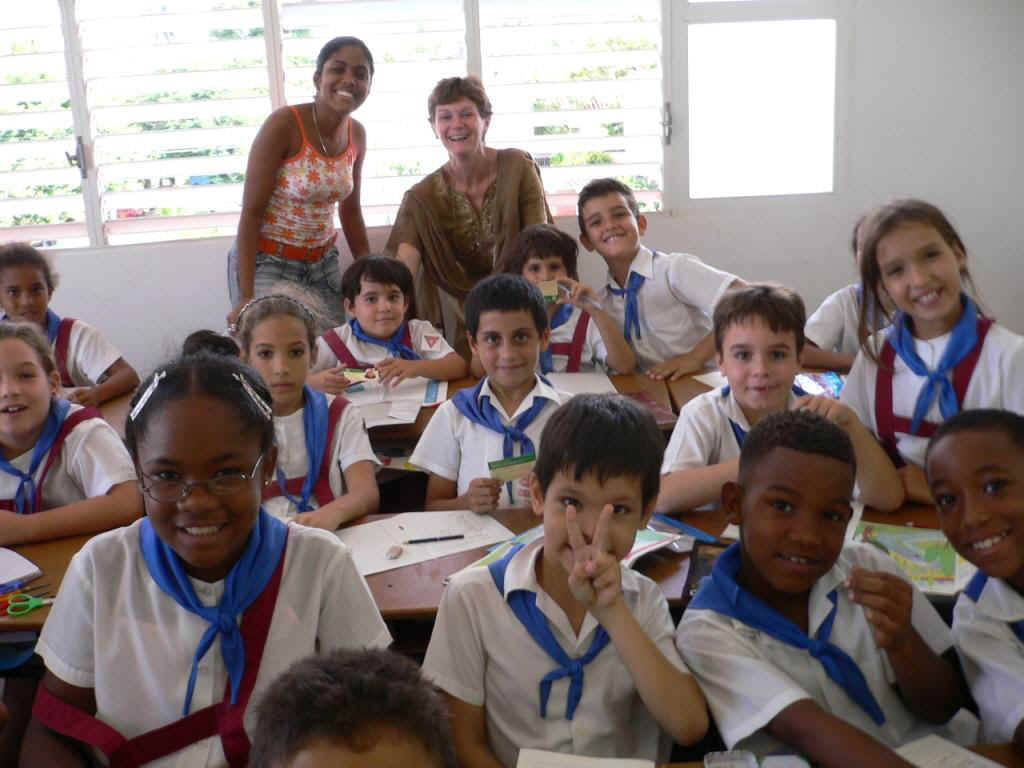 |
On the way to the ballet school, Valentin, one of the protocol officials assigned to the delegation, asked if I wanted to visit a primary school we would be passing by. I eagerly took up the invitation. It took some negotiation to get us in, as we were clearly not expected. The classrooms were small but had no more than 20 children, all of whom seemed engrossed in their work. The class I talked to (pictured here) clearly loved their school and their teacher. All pupils in Cuba wear the same school uniform, with different colours depending on age group.
back to top
At Santa Clara on Sunday, after a very pleasant afternoon at Valadero beach, we had dinner with the Deputy Provincial Governor, who told us his was a full time post paid at the salary of his previous profession, that of a surgeon, at around three times the minimum wage of 200 pesos (8 dollar convertibles). I had read that Cuban politicians are generally part time and receive no more income as a result of their election to political office. Though there are democratic elections with secret ballots and between two and seven candidates for each post, candidates have to have been prior-approved.
We had a discussion about our programme for the next two days, which included a visit to a cardiac hospital, one of several specialist units. At the mention of a psychiatric hospital, I expressed an interest in a visit there rather than what was organised. For various (inconsistent) reasons, this was not possible.
At the cardiac hospital, we saw single rooms with TVs for post-operative patients and, apart from the disgusting visitors’ toilets at the entrance, facilities seemed excellent. It was explained that, because of the blockade, there was a lack of competition between suppliers and so they were having to pay premium prices for essential equipment- a disgraceful situation. At our request, we were also taken to the adjacent cancer hospital, where conditions were not great. We saw a couple of mixed sex wards where people were being given chemotherapy in fairly crowded conditions. Once more we were reminded that this is a very poor country achieving beyond all expectations.
The university in Santa Clara had been founded in 1948. Che Guevara had had a base at the University during the Revolution and had been awarded an honorary degree. We saw postgraduate laboratories that reminded me of my own undergraduate days but which would be unrecognisable to UK students in biosciences today. International journals were not available in the sparse library. Students drummed up without warning to have a question and answer session with us seemed uncomfortable apart from one or two who were clearly aiming to be accredited members of the Communist Party. I reckon these students would have been getting an excellent education in the basics but lacked access to the latest technologies, not necessarily a bad thing if students are to really understand their subject.
Santa Clara would be a fairly uninteresting town were it not for its association with Che. The first picture is of an open air museum commemorating the successful interception of an enemy train. Other pictures are of the Che memorial and of the mausoleum containing his remains and those of other revolutionaries.
back to top
Next day we were off to the municipality of Manicaragua and then on to hillside villages. At Manicaragua, we met the Secretary of the People’s Assembly, who seems to be the equivalent of a mayor. The military fatigues he was wearing symbolised nothing more than the fight against the mosquito and Denghe disease! At the Biotechnological Institute we had heard of their work on anti-virals for Denghe. The Cubans take this disease very seriously and, at the border between principalities, all vehicles are stopped and doused in insecticide. We witnessed this on our trip to Santa Clara. No one knew what the insecticide was and I wondered about the health of the operatives who get covered in the spray. This is obviously seen as unimportant in relation to the deadly potential of the disease.
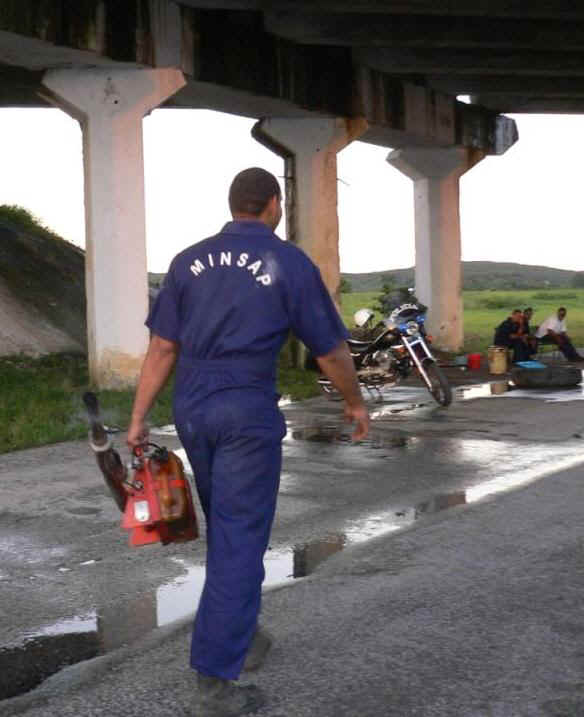 |
Manicaragua has a population of 75,000. It is a mountainous agricultural area, producing coffee, tobacco, milk and beef. The “mayor” told us the conditions for people living in the mountains were good and so there was no depopulation. They had 149 schools, 52 with less than 10 pupils, 13 with less than 3 and 9 with only 1 pupil yet 2 teachers - as every school has to have a computer specialist! Although understanding of IT is given a high priority, access to the internet is only available through workplaces or other controlled public places such as internet cafes, not in the home. In remoter areas, after 5th grade, children are sent to boarding schools. Manicaragua has 134 doctors, of which 118 are GPs, equivalent to one doctor per 300 people! Specialist outreach clinics, including in psychiatry, also took place. The emergency services system included boat ambulances in lake-side areas.
The “mayor” told us that in 1998 the average salary was 98 pesos a month. It was now 325 pesos. Prices had been stable apart from in 2002 when American dollars ceased to be recognised and were replaced with Cuban Convertible Pesos (CUCs) worth 25 Cuban pesos. I took home most of the US dollars I had brought with me (left over from my abortive trip to Israel) because of the poor exchange rate. Euros are definitely the ‘in’ currency. The increases in wages followed an analysis of the people’s needs, informed by the grass roots, and what the Country could afford.
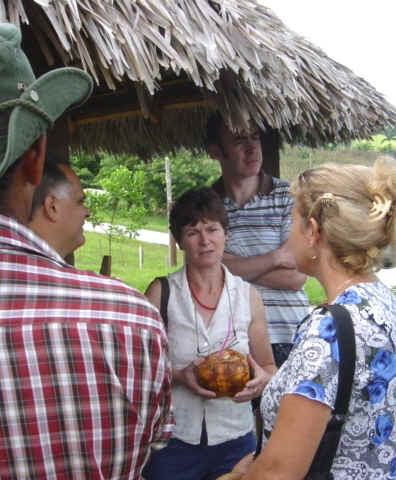 |
On the way to our destination in the mountains, we stopped at a small place with an area for villagers to congregate with fixed seating and a thatched roof In another building, thatched in the shape of a star, there was a small exhibition of the Revolution. Refreshments of coconut milk and the delicious “meat” were provided. The location looked idyllic. One of our delegation tried to give some money in payment. This was refused, though later accepted when officials were no longer near. I also left some soap and toothpaste. A couple I spoke to, who were manual workers, proudly told me their daughter is studying to be an orthopaedic surgeon.
back to top
An hour later we stopped at a mountain village where the President of the Local People’s Assembly told us there were seven settlements with two primary schools, one secondary school and one senior high school, two hospitals and one commercial centre with twelve shops including six bars and two cafeterias and one restaurant. They had nine family doctors and a school for physical education to train teachers. We were in the cultural house, a good facility for community events, and were later entertained by two singers. Both shared the same guitar.
I asked how many women were on their Assembly: only one woman out of eleven and she was the representative of the Women’s Federation! Other bodies sending representatives were obviously male dominated, for example the Committee for the Defence of the Revolution and the National Association for Small Farmers. There had been no attempt at gender balance in the representatives that were ex-officio. The Assembly met monthly and produced an annual action plan. People looked completely non-plussed at any suggestion that anyone other than agents of the US would criticise the Cuban system. They seemed unaware of national news, such as the petition collected by Oswaldo Payer, calling for a change in the constitution. We were told that “we follow our model and wouldn’t think of doing it any other way”. As is so often the situation in Cuba, the toilet in the culture house did not flush and there was no running water or soap, or toilet paper. I left my last bar of soap there.
We then went to what was described as a poly clinic financed by the Pan-American Health Organisation, an arm of the WHO, the purpose being to improve the living conditions of the mountain people. The clinic is open 24 hours a day and has three hospital beds and four maternity beds. They also have intranet connections for teaching and training. They had four newly graduated dentists who would be there for two years. All four maternity beds were occupied. Women are brought here at 36 weeks pregnancy for observation then sent to Manicaragua at 38 weeks, and hence to Santa Cara for the actual birth. They proudly showed us their ultrasound equipment. However, here also the toilet did not flush and there was no soap. This medicalisation of childbirth is reminiscent of what happened with the NHS in the 50s, but it does result in a very low mortality rate. However, I would have hated being subjected to such boredom for so long when I had my two babies (the last one at home).
Next we went to a place where traditional or ‘green’ medicines are prepared. There was basic equipment for the extraction of compounds of active ingredients from plants after grinding up with methanol. Their main product seemed to be an agent that increased blood pressure and acted as a stimulant and also possibly as an aphrodisiac! We met a group of technicians, all female (one male technician was absent). When asked if they were free to go abroad, they said yes, to help other countries improve their health. In reality it is difficult to get a permit to leave Cuba except for approved purposes because of a fear that people would not return. Though there are many benefits of the welfare state, the lure of wealth abroad is very real, more particularly, I felt, for the less educated than those with higher status in Cuba. Here again, it didn’t seem to enter the heads of those most benefiting from Cuba’s excellent education system that their freedom was in any way restricted.
back to top
On Wednesday morning, we had an early start. Apart from our tourist coach, the only other vehicles on the road were bicycles and horses and tractors pulling traps, often loaded with people. One man with a bike was using a scythe to cut the grass verges. We passed through many small places, some with Spanish colonial squares and neat single story houses arranged on a grid road system. On many street corners, people gathered to hitch a lift. Public transport is inadequate.
We were on our way to the Bay of Pigs, passing through wetlands with many cattle, goats and horses as well as sugar cane plantations. At the Bay of Pigs, we visited the museum that had been closed, I now learn, through hurricane damage, when I had visited as a tourist in 2002.
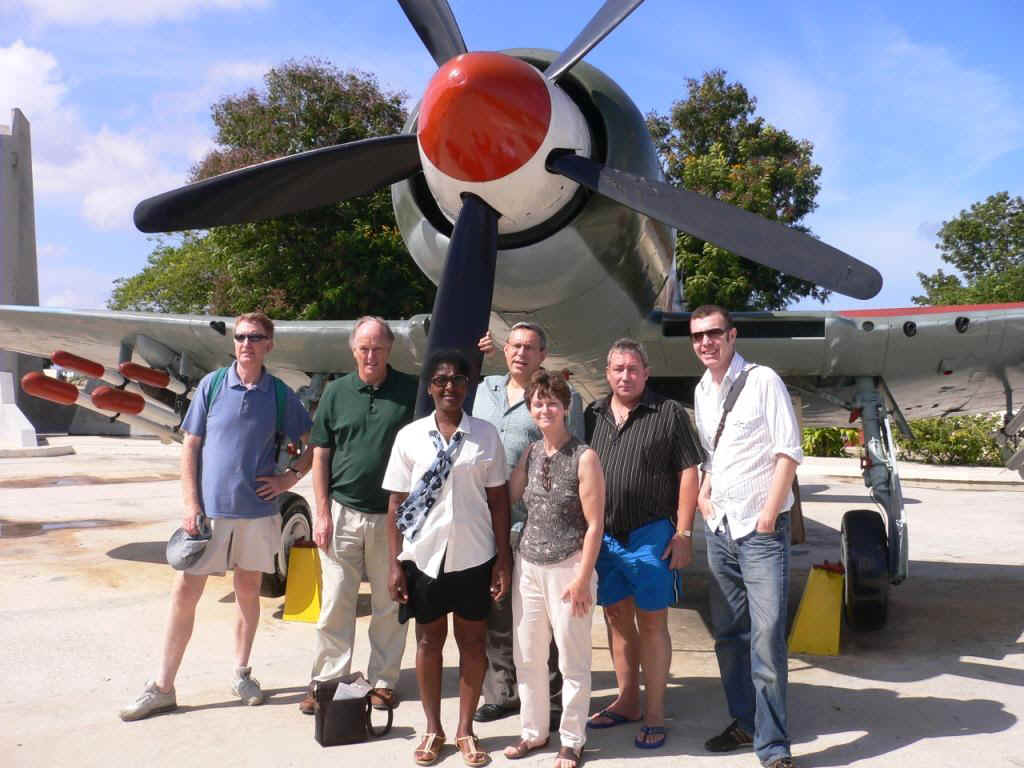 |
The exhibition began with photographs showing the poor living conditions of the people before the Revolution. It was explained that the mercenaries, about 1200 of them, chose this area because it was sparsely inhabited with only a small number of roads to the rest of the island. Their plan was to land and stay there for 72 hours, during which time they would declare themselves the Government and call for help from other countries, i.e. the USA. The mercenaries had been trained in Central American countries with aid from the US, who also supplied aircraft and boats. A number of the mercenaries had been owners of land and enterprises that were confiscated by the Revolution, seeking to reclaim their assets and naively, it seemed to me, believing that the people would welcome their return. The Revolution had been expecting the attack but did not know where it would be. Within three days, from 17-19 April 1961, the incursion was defeated. In the museum, there was a picture of Adelaide Stephens, the US representative at the UN, apparently assuring the UN that the attack was motivated by Cuban people and that his country had nothing to do with it! To me this was a mirror of the lies told before the invasion of Iraq.
back to top
After a long journey to Matanzas, the capital of Matanzas Province, on the north coast we had a very late lunch with the Secretary of the Provincial Assembly of the People’s Power, Mercedes Arana. It was her 49th birthday. Like other Cubans we had met, she took delight in describing the numbers of schools and hospitals. The energy revolution was the latest manifestation of many revolutions in Cuba. People knew that Fidel would not live for ever but his ideas would carry on after his death.
We had a very heated discussion over lunch about the treatment of gay men and women in Cuba. We explained the changes in attitudes in the UK and our new laws against discrimination in employment and the provision for civil partnerships. The discrimination faced by homosexual people in Cuba was attributed to their macho culture, which needed to change and there was little recognition that outlawing discrimination had a role to play in this process.
We also discussed how people came to be members of the Communist Party, a discussion we had had previously with our interpreter, Julio, who was a member of the Communist Youth League but hoped to be made a full member when he was 30. The concept was that the ‘best’ people would be selected to become members of the Communist Party. But it was not necessary to be a member of the Party to be elected by the national or local assemblies. Nevertheless, in the case of the National Assembly, most were. At the lunch was Pablo Odel Marichal, an MP who was also an Anglican priest. Pablo did not seem to have any problem with the role of the Communist Party in Cuban politics and felt no need himself to be a member of the Party. It struck me that being granted membership of the Communist Party is somewhat equivalent to being awarded a UK honour by the Queen for good works. This impression was reinforced in other conversations.
Our final destination that day was to the seminary (where priests are trained) that Pablo helped to run. There we met people from US and Canadian churches that helped to fund the seminary. We heard that the US will give permits for religious organisations to visit their counterparts in Cuba, but the process is very tedious. One of the American women spoke for everyone there when she said that although the US was responsible for the crumbling buildings in Cuba, they lacked the ability to crush the Cuban spirit, which they all seemed to admire. I couldn’t have put it better.
back to top
We were all looking forward with interest to Thursday morning’s visit, described on our programme as a penitentiary centre. It turned out to be a women’s prison on account of it being “the nearest”. On our arrival we were greeted by a group of prisoners lined up at the entrance. One of them read out a speech which ended with the statement that they were engaged in “the beautiful work of converting prisons into schools”. Some of the prisoners were wearing their own clothes rather than the blue prison uniform consisting of shorts and blouse, which I thought rather attractive. We were told this was a privilege that prisoners earned for good behaviour. Whether in uniform or not, most wore make-up. We were given a briefing by the Deputy Head of Penitential Centres, who is based in the Ministry of the Interior.
|
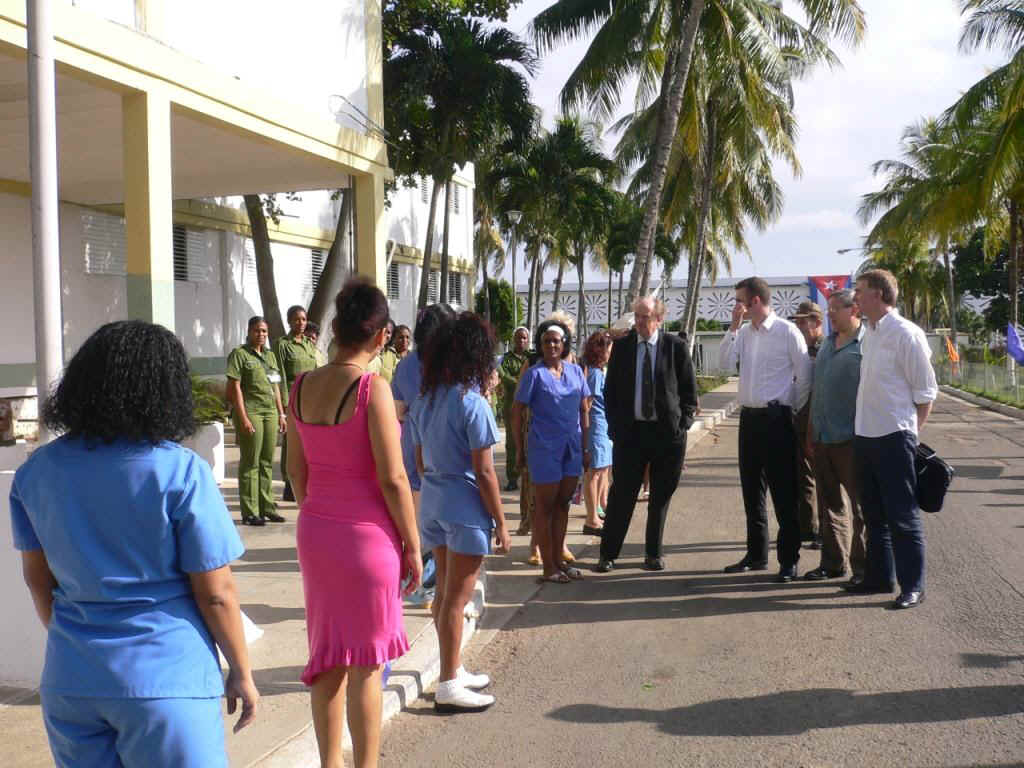
|
This was the prison serving the whole of Cuba for the women who had committed the most serious crimes. There were 1200 places at the prison and 800 inmates at present. Each of the fourteen provinces had their own local women’s prison to try and house people as near as possible to home. 4% of prisoners are women. Our questions about the total numbers imprisoned in Cuba were sidestepped. Doing a rough calculation, based on 150 in each provincial prison (he said numbers were from 400 but down to less than 100 in many), I estimated a total prison population of the order of 72,000. Scaling up to the British population this would be equivalent to nearly 400,000 prisoners, compared to our (all time high) prison population of nearly 80,000.
back to top
We were told that there had been a transformation of the prison system since 1961 with the emphasis now being on education and rehabilitation rather than the cruel system of pre-revolutionary times. They have a full range of education programmes to all levels, including undergraduate and post-graduate levels. Some inmates were training to be teachers, cascading the educational effect. In open prisons, inmates worked in construction and agriculture and in socially useful work in schools and hospitals. We had another discussion about the treatment of gay people by the prison system and received an acknowledgement that, in the past, there had been special prisons for ‘re-programming’ homosexuals. The Cuban macho culture was again blamed for this but it was emphasised that today homosexual people have the same rights.
There was a 40-45% re-offending rate (compared to 67% in our system) and all prisoners were guaranteed a job on release. There was a system of parole, which, for first time offenders could result in them being released after having served a third of their sentence. It was acknowledged that there were “no more than 200” political prisoners. But it was denied that these were prisoners of conscience. Rather they were people that had committed crimes that had affected the stability of Cuba. Our attention was drawn to a King’s College study of the Cuban penitentiary system but the only copy was in Spanish. I made a mental note to contact Kings on my return.
We were then able to visit foreign prisoners in their cells, most of whom seem to have been convicted of drug trafficking. A Venezuelan woman I spoke to was serving a 25 year sentence, having made the mistake of stopping to Cuba en route from Panama. Most had their own cell but two Colombian women showed me their shared cell. They had a clean toilet and shower and plenty of toiletries. The prison facilities seemed cleaner than the clinic we had seen the day before and there was no hint from the attidude of the prisoners that this was put on for our benefit though one did complain about the food. We also visited the mother and baby unit. Mothers can keep their babies until one year of age. We saw educational classes taking place and spoke to a group of prisoners in their library. One woman was a physics teacher and another had a degree in biochemistry. She had served 8 years of a 15 year sentence for murdering her husband. She was likely to be released soon and was in her own clothes. Finally, we went to the prison theatre where we were entertained with dancing and singing and also a presentation in Spanish about the Miami five. Everywhere you go in Cuba you are likely to see a display about the unjust treatment of these five men whose wives we were due to meet. As we left, lunch was being brought in. I lifted the lid on the soup kettle, the contents of which looked appetising, certainly better than the food I once saw being served to prisoners at Winson Green, which had made me heave.
back to top
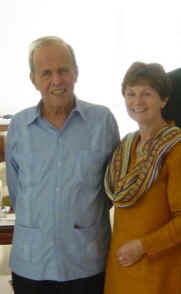 |
Later that day we had the best lobster I had ever tasted at lunch with Ricardo Alarcon, President of the National Assembly of the People’s Power, followed by a meeting at the Ministry of Tourism. Alarcon is one of the most powerful people in Cuba, who like all the national politicians we met, acknowledged the need for more freedom for the Cuban people. Despite Cuba’s harsh penalties for drug trafficking, he turned out to be surprisingly libertarian on drugs, agreeing that prohibition couldn’t work. However, if Cuba took anything other than a hard line, what further vitriol would they have received from the US - a similar sentiment to that expressed to me when I visited Colombia. When Ricardo hesitated in answering our question about what is the most important change he would like to see in Cuba, Roberto, the poet politician we had met on our first day, said phasing out the dual currency system. Ricardo, and Ramon - who had also joined us for lunch, agreed, which pleased me greatly as, when I had visited Cuba previously, this was the conclusion I had also come to.
back to top
Our meeting with the wives of Fernando, Geraldo, Ramon, René and Antonio was televised on Cuban TV. The “Miami 5” are regarded with reverence in Cuba as their work was seen to be in combating terrorism against the Cuban state and there is much condemnation of what is seen as US hypocrisy over the “war on terror”. They point out that the person responsible (Rluiz Prasada Carules) for the terrorist attack in 1976 on a Cuban flight, killing all 73 on board, is held only on charges in the US of illegal entry. Apparently Bush Snr pardoned Carules’ accomplice. Cuba provided information to the United States based on evidence collected by the Five but this has been ignored. Instead the Five were arrested.
The imprisonment (often in long periods of solitary confinement) of the Five has been condemned by the United Nations, and, in 2005, even the US Federal Court of Appeals ordered a new trial. However, this year the decision was overturned. Adriana Perez, wife of Geraldo, has been denied the child they both longed for as a result of their separation since 1998. She has not seen her husband for 6 years and her most recent application has again been refused. Olga, wife of René has not seen her husband for eight years. Olga, Adriana and Elizabeth were happy to have my photograph taken with them and I asked them to keep in touch, particularly about the reasons for refusing access.
back to top
On Friday we had a bit of a break visiting a cigar factor. Even there, cigars cost 16 CUCs (about £10) each. So, as a non-smoker, there was no temptation to buy. However, it was interesting seeing cigars made, particularly in the hall with trainee employees whose production is given to elderly Cubans at the rate of two a month. Skilled workers are given two branded cigars a day which is obviously extremely valuable on top of their good pay, at least by Cuban standards. They receive 200 Cuban pesos per month plus 42 CUCs. This is surely an example of the pragmatic approach being taken by the Cuban Government. These measures ensure that it is not worthwhile for these workers to steal to feed the black market, which is thereby kept in check. Cubans need hard currency to buy what for us are basic necessities such as soap and household appliances. Most Cuban households have a TV and refrigerator, but they are usually given by the Government, not purchased.
back to top
At the Ministry of Justice, in an excessively lengthy presentation, we were told about the anti-drug trafficking work being done with the support of the British. They were proud of their work and there is very little drug misuse in Cuba. However, unlike Alarcon, they could not understand the point of view expressed by some of us, that, despite Cuba’s effectiveness, plummeting street prices in the UK and US show that attempts to restrict supply have failed to deal with the problem. They were aggrieved that the US Government did not acknowledge their work.
Like the people at the prison, the Minister of Justice was very cagey about disclosing the number of prisoners in Cuba but eventually conceded a number of 40,000, the last time he said he had the figures. Even accepting this figure, about half of my own estimate, it is still a very large prison population, though about half the incarceration rate in the US. Once more it was vigorously denied that Cuba had any prisoners of conscience but the Minister agreed to respond to the information on specific cases provided by Amnesty International. I got his email address to make sure that I could contact him direct and Amnesty have now supplied me with the information that will allow me to do so.
back to top
The impression we got at a later meeting, with officials responsible for European relations in the Cuban Foreign Office, was of much more openness and acceptance that Cuba had to change. There was, nevertheless, criticism of the British line on the 2003 sanctions, which were only temporarily suspended. The Czech Republic and Poland were definitely seen as the bad guys for supporting US policy. We were told of enthusiasm for joint ventures such as in tourism, oil, computing and telecommunications and we agreed to raise this with the DTI. They clearly had no problem with working with capitalism!
I had a long discussion with one of the officials who was very explicit that Cuba needed more democracy. Although a member of the Communist Party, he also maintained that this did not help a person in their career. Half of the employees at the Ministry were not members of the Communist Party. My impression of all the Communist Party members I met was that they were very nice people guided by altruism not personal gain. They certainly did not enjoy the sort of lavish lifestyle associated with the elite of many other corrupt regimes that called themselves communist.
The last official visit was to the Latin American School of Medical Sciences which takes 1500 foreign medical students a year. Most are from Latin America but there is growing participation from Africa. 50 US students are nominated by Lucius Walker of Pastors for Peace. The Cuban Government pays not only for the cost of their education, three years at the School and the rest in clinical placements, but also for their board and lodging and 100 pesos a month spending money. By my reckoning this would put Cuba well ahead of the 0.7% UN target for overseas aid that most developed countries, including our own, are failing to meet!
back to top
On Saturday, our last full day, we all went our own separate ways in the centre of Havana. I got talking to Carmelo, a musician, and Josè, a hospital worker, whose promise of lots of Cuban music in commemoration of the second anniversary of the death of Compay Segundo at a nearby bar did not materialise. I ended up buying them a very expensive lunch at a restaurant that did at least have a band. I was glad I had split my cash between two bags and I was seen to scrape together just enough CUCs to pay the bill and tip the band (not as much as they would have liked). Seeing I also had a $US 20 note, Carmello asked for it to buy some “milk for the children”. Milk is not that expensive in Cuba so I declined and our encounter ended on a sour note. Carmello and Josè, whilst expressing a liking for Castro, complained about their standard of living, particularly housing, and disputed the exixstence of a large programme of new homes even though I said I had seen them being built. Whilst they seemed to regard the US as some sort of promised land, their enthusiasm seemed to be tempered by anxiety over the availability of free healthcare.
That evening, we treated Ada and Julio to a meal at a very good restaurant they recommended, which had very reasonable prices and chicken that tasted as it used to when it was a luxury in the UK.. We discovered that Ramon was Ada’s husband. They live on the fourteenth floor of a tower block in Havana, which reinforced my impression that important people in Cuban society lived very modestly.
back to top
So how do I sum up this visit? Travelling to and around Cuba gave me time to read “The Good Society”, published by Labour’s newest “ThinkTank”, Compass. This describes how the unequal accumulation of affluence has been associated with social recession and puts forward ideas to make good our social deficit to create a truly “good society”. As a privileged person in the UK, I would not swap my life but my visit reinforced my view that, in Cuba, there is a real sense of community and such a concept is a reality there. Sure, people are poor, but everyone has sufficient food and access to good education and healthcare.
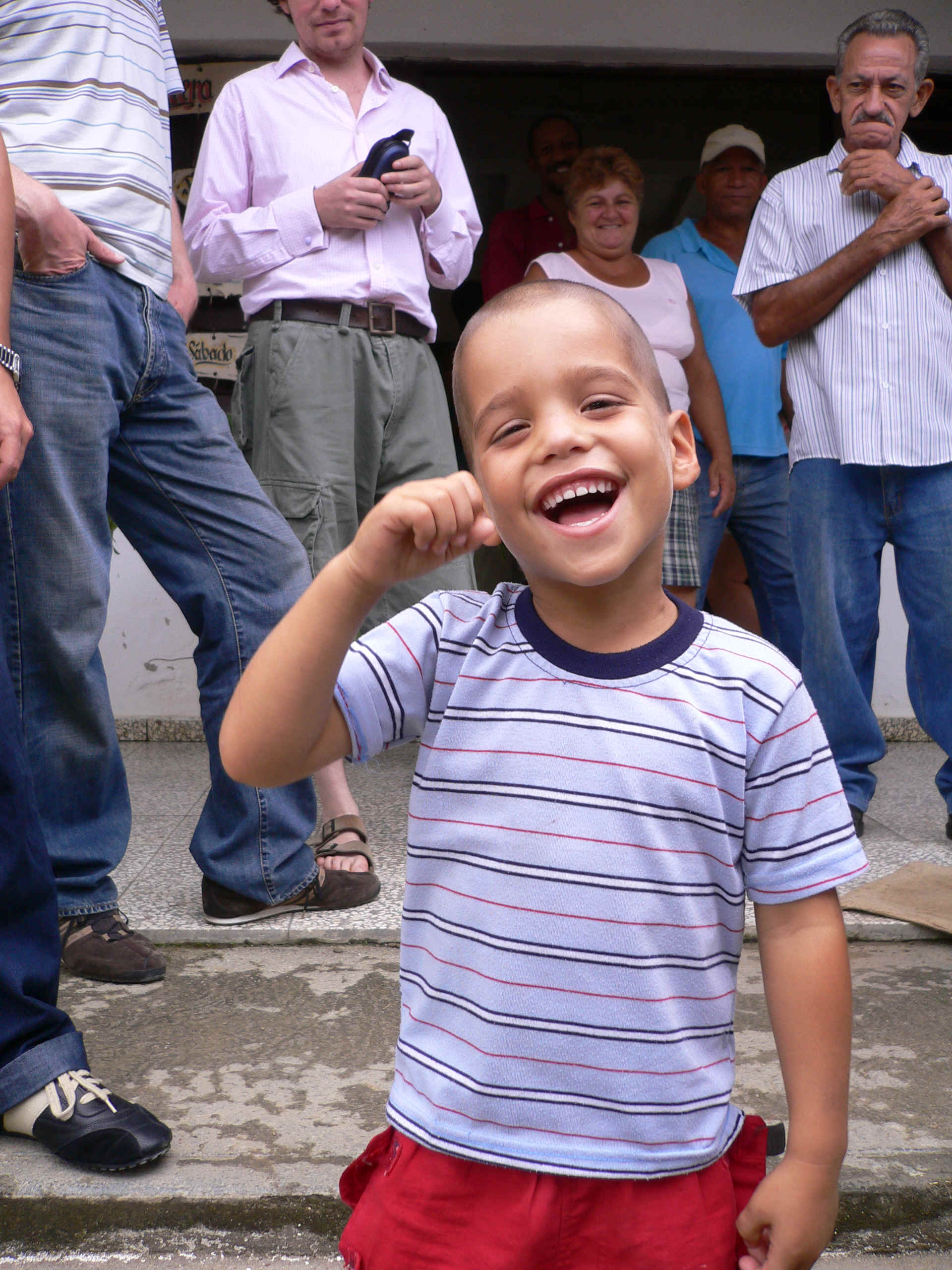 |
Cuba’s leaders need have less fear of genuine dissidents and should stop denying the attraction of the wealth of the US but, instead, highlight its downsides – particularly the lack of public services –just compare how the two countries dealt with Hurricane Katrina! Post Castro, interference from the US will still be counterproductive and rightly viewed as ideologically driven, given the human rights records of states the US does engage with. Complaints by independent bodies such as Amnesty, should be pursued vigorously and I will report on my efforts in this regard.
The Revolution is deeply embedded throughout Cuban society and, the death of Castro will not change this. But there are hopeful signs of a deep recognition at the highest levels of the need to evolve. Let Cubans do this themselves.
back to top



